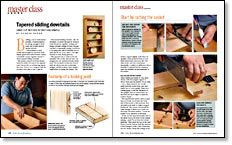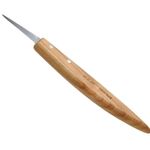How to Cut Tapered Sliding Dovetails
Hand-cut method is fast and simple
A locking joint with a forgiving nature, the tapered sliding dovetail is ideal for open bookcase shelving that is rigid and sturdy. San Antonio woodworker George Huron explains in this article how he cuts this joint using hand tools.
Building a set of wall shelves recently, I wanted them to be strong enough to hold some real weight and yet appear delicate.
A face frame or back would add strength but spoil the look. Simple glued dado joints weren’t certain to hold the carcase together. Instead I chose tapered sliding dovetails.
This project requires well-developed hand-tool skills, but part of the tapered joint’s beauty lies in its forgiving nature. You don’t have to be a surgeon with the backsaw and chisel to get a tight fit.
The standard sliding dovetail—like all dovetails—is sturdy because its structure locks the pieces together. Cutting and fitting a straight sliding dovetail, though, can lead to repeatedly paring wood from a too-snug joint only to find that you’ve made the fit too loose. And a very tight fit tends to bind during glue-up.
This tapered joint is easier to fit and assemble. The socket and tail have one straight and one tapered dovetail cheek each. The dovetails on the end of each shelf are driven into the sockets like wedges, and the surfaces mate despite small errors in cutting the joinery. The shelves, ripped slightly wider than the uprights, stand proud in front or back. Plane them flush and you’re left with clean looks and very sound joints. Structurally, it makes no difference which shoulder is tapered, but be consistent. I taper the shoulder on the underside of the shelves.
Lay out and cut the sockets
These shelves are made of 1⁄2-in.-thick cherry, with the uprights ripped to 45⁄8 in. wide and the shelves 53⁄8 in. wide.
Use a sharp pencil to lay out the shelf locations on the front, rear, and inside face of each upright. Then set a cutting gauge to half the thickness of the uprights and cut vertical lines on the front and back edges to mark the socket’s depth.
From Fine Woodworking #178
For the full article, download the PDF below:
Fine Woodworking Recommended Products

Veritas Standard Wheel Marking Gauge

Pfiel Chip Carving Knife

Freud Super Dado Saw Blade Set 8" x 5/8" Bore




















Log in or create an account to post a comment.
Sign up Log in